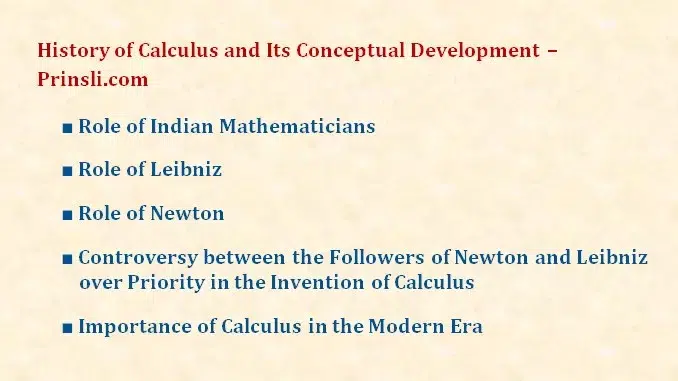
History of Calculus and Its Conceptual Development
Calculus is a branch of mathematics that deals with the study of change and has a wide range of applications in science, engineering, economics, and a variety of other fields.
Calculus has a long and distinguished history that dates back to ancient Greece when mathematicians such as Eudoxus and Archimedes developed early methods of quantifying change. However, for centuries, mathematicians in the West were unaware of the work of Indian mathematicians, who played a crucial role in the development of calculus.
■ The Role of Indian Mathematicians in the History & Development of Calculus
The work of Indian mathematicians, who were significant in the development of calculus, was, nevertheless, unknown to Western mathematicians for centuries. Western mathematicians were unaware of the contributions of Indian mathematicians, who played a significant role in the development of calculus.
In the early 12th century, Indian mathematician Bhāskara II wrote a commentary on the Aryabhatiya, an ancient Sanskrit astronomical treatise. In this commentary, Bhāskara II described methods of integration, a fundamental tool in calculus.
The Indian mathematician Mahavira in the 13th century also developed methods of integration.
Throughout the next few centuries, these methods were further developed by Indian mathematicians, including Madhava and Nilakantha in the 14th century.
Later, at the Kerala School of Astronomy and Mathematics, some concepts on calculus appeared in Indian mathematics. In the 14th century, mathematicians Madhava of Sangamagrama and later Kerala school mathematicians stated components of calculus like the Taylor series and infinite series approximations. They did not, however, combine many differing concepts under the two unifying themes of the derivative and the integral, show how the two are related, and turn calculus into the powerful problem-solving tool we have today.
In the 16th century, the mathematician Jyeshthadeva wrote the first comprehensive treatise on calculus, the Yuktibhasha. This treatise was then translated into Latin by scholars such as Pierre Gilles in the 16th century.
In the 17th century, the mathematician Leibniz laid the foundations for the modern form of calculus. He was inspired by the work of Indian mathematicians, as he had become aware of their work through the Latin translation. Leibniz developed the basic principles of differentiation and integration, which he used to solve a variety of mathematical problems.
In the centuries since then, calculus has been extended and refined and has become a fundamental tool in mathematics and science. The role of Indian mathematicians in the development of calculus is often overlooked, but it is important to recognize the contributions they have made to the development of this powerful mathematical tool.
Read Also – History, Origins, and Development of Graph Theory
Throughout the past few decades, a marked change in our understanding of Indian mathematicians’ contributions has occurred. To enhance our understanding of the contributions made by Indian mathematicians whose work has unfortunately been lost or, maybe worse, neglected, much more effort and work need to be done. In fact, work is currently being done, and in a short while, we should have a better understanding of this important part of the history of mathematics.
■ History & Conceptual Development of Calculus
We often read that Gottfried Wilhelm Leibniz (1646–1716) and Sir Isaac Newton (1642–1727) were the inventors of calculus. But, we are aware that the basic concepts of “integration” were investigated by ancient Greeks such as Eudoxus and Archimedes over 2500 years ago, and Pierre Fermat (1601-1665), Isaac Barrow (1630-1677), and others invented methods for finding tangents.
Isaac Barrow, Newton’s teacher at Cambridge, was the first to understand the “inverse relationship between differentiation and integration”. Newton and Leibniz used this relationship in the form of the fundamental theorem of calculus to develop calculus into a systematic mathematical discipline. In this sense, Newton and Leibniz are credited with the invention of calculus.
■ Development of Calculus in the 17th century
The most important development in the history of the calculus was the work of Isaac Newton and Gottfried Leibniz in the 17th century. Newton and Leibniz independently developed a system of calculus, known as “Newtonian” or “Leibnizian” calculus, which was based on the concept of a derivative. This derivative allowed them to determine the rate of change of a given quantity and to solve various mathematical problems that would have been impossible to solve using standard methods.
Hence, the development of calculus is widely credited to the works of both Isaac Newton and Gottfried Wilhelm Leibniz during the 17th century. While Newton is often associated with the beginnings of calculus, Leibniz is widely credited with introducing the notation and the modern approach used to this day.
The work of Newton and Leibniz was followed by a period of intense research into the application and development of calculus. This period produced several important results, such as the Fundamental Theorem of Calculus and the development of differential equations.
Read Also – History, Origins and Development of Factorial Notation
■ Development of Calculus in the 19th century
In the 19th century, calculus was further developed by mathematicians such as Augustin-Louis Cauchy and Karl Weierstrass, who developed a rigorous approach to calculus, known as the “Cauchy-Weierstrass” approach.
■ The Role of Leibniz in the Development of Calculus
The development of calculus is widely credited to the works of both Isaac Newton and Gottfried Wilhelm Leibniz during the 17th century. While Newton is often associated with the beginnings of calculus, Leibniz is widely credited with introducing the notation and the modern approach used to this day.
He helped father the Fundamentals Theorems of Calculus through his calculations. The notation “dx/dt=v(t)” is one of his very first notations.
Leibniz was born in 1646 in Leipzig, Germany. As a child, Leibniz was educated in philosophy, mathematics, and law. He studied various branches of mathematics, including geometry, algebra, and trigonometry. After graduation, he continued to study mathematics, focusing on calculus and its many applications.
Leibniz’s main contribution to the development of calculus is his use of infinitesimals, or infinitely small quantities. He used these to describe certain phenomena with fractions that were too small to be measured. This allowed him to derive equations and make predictions with greater accuracy.
Leibniz also introduced the use of symbols and a unified notation for calculations. This notation was easier to use than the cumbersome one used by Newton. This helped popularize calculus and allowed it to reach a larger audience.
Leibniz’s notation and approach to calculus made its use much easier, leading to its widespread adoption. His approach is still used today, making Leibniz one of the most important figures in the history of mathematics. Without his contributions, calculus would not have reached the level of sophistication it is today.
■ The Role of Newton in the History & Development of Calculus
Sir Isaac Newton is often referred to as the “Father of Calculus” due to his considerable contribution to the field in the 17th century.
His seminal work, the Philosophiæ Naturalis Principia Mathematica, laid down the groundwork for the development of calculus and laid the foundation for further advances in mathematics.
Newton developed the first set of calculus techniques which allowed mathematicians to calculate areas and volumes. He also created the first set of basic rules for integration and differentiation. This paved the way for higher mathematics and allowed scientists to develop more sophisticated calculations.
Newton also developed the fundamental theorem of calculus which states that the integral of a function is equal to the limit of the sums of its derivatives. This theorem laid the foundations for more advanced mathematical calculations and set the stage for the application of calculus in many fields, including science and engineering.
Newton’s work revolutionized mathematics and set the stage for future advances in calculus and mathematical sciences. His contributions laid the foundations for the development of powerful analytical tools which are still used today. His work is recognized as one of the most influential contributions to mathematics.
■ Controversy between the Followers of Newton and Leibniz over Priority in the Invention of Calculus
The debate over who first invented calculus has been a subject of contention for centuries, with the followers of both Newton and Leibniz claiming priority. Isaac Newton and Gottfried Wilhelm Leibniz developed calculus independently of one another in the late 1600s, and both published their findings in the early 1700s. Although both mathematicians made significant contributions to the development of calculus, the question of who first invented the mathematical system has been widely contested.
Some historians argue that Newton had already developed the principles of calculus before Leibniz, while others argue that Leibniz was the first to fully develop the concept. The debate has been further complicated by the fact that Newton and Leibniz had very different approaches to mathematics, making it difficult to directly compare the two.
For a long time, the followers of Newton believed that he was the one who had invented calculus first, and the followers of Leibniz argued the opposite. However, more recently historians have begun to acknowledge that both men made significant contributions, and that the invention of calculus was likely a collaborative effort.
The debate over who invented calculus is still ongoing, and it is unlikely that there will ever be a definitive answer. However, it is clear that both Newton and Leibniz made major contributions to the development of the mathematical system, and that without the work of either mathematician, the development of calculus would have been significantly delayed.
■ Importance of Calculus in the Modern Era
In the modern era, calculus is used in virtually every field of science and engineering and is a vital tool for understanding the physical world. It is used in fields such as physics, astronomy, chemistry, economics, and computer science, to name a few. Calculus is also used in a wide variety of practical applications, such as designing aircraft and automobiles, producing pharmaceuticals, and developing computer algorithms.
(Source – Various Books from Library)
Copyrighted Material © 2019 - 2024 Prinsli.com - All rights reserved
All content on this website is copyrighted. It is prohibited to copy, publish or distribute the content and images of this website through any website, book, newspaper, software, videos, YouTube Channel or any other medium without written permission. You are not authorized to alter, obscure or remove any proprietary information, copyright or logo from this Website in any way. If any of these rules are violated, it will be strongly protested and legal action will be taken.





Be the first to comment